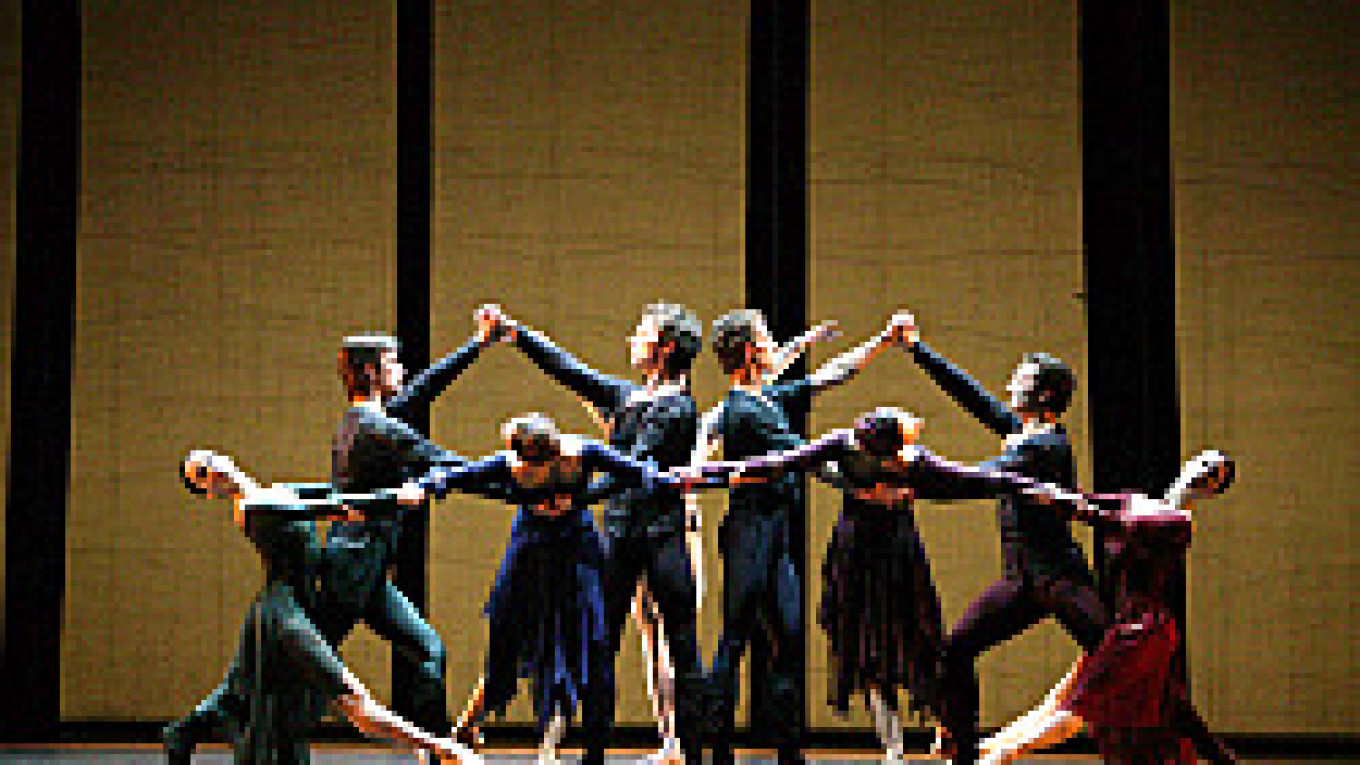The one misfire on the program was Balanchine's "Serenade," a work of breathtaking beauty set to Pyotr Tchaikovsky's Serenade for String Orchestra and created in 1934, shortly after Balanchine's emigration across the Atlantic, for pupils of his then newly founded School of American Ballet. Among the most "Russian" of the great choreographer's many ballets, "Serenade" owes much to his earlier training as a dancer in his native St. Petersburg. But the movements of legs, arms, hands and heads nevertheless have about them an elusive quality that is very much of Balanchine's own making.
Of the other Balanchine works staged at the Bolshoi since the late 1990s, only the severely modernistic "Agon" could be called a real success. And despite some highly skilled coaching by former Balanchine lead dancers Francia Russell and Suzanne Schorer, the Bolshoi company failed once again, with "Serenade," to offer more than a very approximate replica of the look and feel of performances such as the many I witnessed during the height of Balanchine's reign at the New York City Ballet in the 1950s and '60s.
Among two partly different casts seen at the first and last of February's three premiere evenings, only the Bolshoi's latest dancing wonder, 21-year-old Natalya Osipova, managed to display the necessary grace and agility. The rest, including a somewhat ragged corps de ballet, seemed to have little clue as to what "Serenade" really required.
The remainder of the triple bill, however, proved an overwhelming success. "Misericordes," an entirely new work by the acclaimed young British choreographer Christopher Wheeldon (and originally announced by the Bolshoi in the misspelling "Misericors"), could be called American only by virtue of the fact that Wheeldon has spent nearly all his career at work with the New York City Ballet. But that should hardly matter to any but the most pedantic. For "Misericordes" is quite simply a masterpiece of original and enthralling dance.
In the space of a mere 20 minutes, Wheeldon manages to create an entire world, a shadowy, medieval place suggested by Shakespeare's "Hamlet" and by the solemn, often clangorous orchestral score that contemporary Estonian composer Arvo Part based on his studies of music from the Middle Ages. On stage are four couples dressed in various dark colors, plus a brooding figure -- perhaps the Prince of Denmark himself -- in a pale-color costume. Wheeldon's choreography, though essentially classical, bends and wrestles the dancers' bodies to the very limit. Emotions surface and disappear. Love, hate and hints of doom all seem to be present.
The result is a marvelous piece of theater for which each viewer is free to create his own plot. And as with Balanchine, with whom Wheeldon has often been compared, all that takes place in the dancing seems to arise directly from the music, as if Part had written his Symphony No. 3 nearly four decades ago with Wheeldon's ballet in mind.
The single cast at all three performances of "Misericordes" last month danced superbly. Particularly outstanding were the severely testing solo carried off with aplomb by Maria Alexandrova and the long and wonderfully sinuous duet allotted to Svetlana Lunkina and Ruslan Skvortsov.
"An Evening of American Choreography" came to a smashing conclusion with Twyla Tharp's "In the Upper Room," a work first danced by Tharp's own company in 1986 and subsequently taken up by ballet companies throughout the world. The ballet's curious title comes from a reference in a song by Mahalia Jackson to the room in which the Last Supper took place, and the number of dancers equals the 13 who were present there, that is, Christ and the 12 Apostles.
Whatever Tharp may have had in mind concerning the Bible, her eclectic mixture of classical and free-form dancing is thoroughly rooted in the modern world. To the pulsating beat of avant-garde composer Philip Glass' electronic score, the dancers whirl and twirl, in various combinations, through an unbroken sequence of nine scenes, the entire company coming together at the end in an utterly dazzling finale.
Both casts that appeared at the February performances danced "In the Upper Room" to a well-deserved storm of cheers and applause. Once again, as in "Serenade," it was Osipova, among the opening night cast, who stole the show. In both modern works and the classics, she definitely leads the way among the Bolshoi's youngest generation of dancers.
"An Evening of American Choreography" (Vecher Amerikanskoi Khoreografii) plays Tues. and Wed. at 7 p.m. on the New Stage of the Bolshoi Theater, located at 1 Teatralnaya Ploshchad.? Metro? Teatralnaya. Tel. 250-7317.
A Message from The Moscow Times:
Dear readers,
We are facing unprecedented challenges. Russia's Prosecutor General's Office has designated The Moscow Times as an "undesirable" organization, criminalizing our work and putting our staff at risk of prosecution. This follows our earlier unjust labeling as a "foreign agent."
These actions are direct attempts to silence independent journalism in Russia. The authorities claim our work "discredits the decisions of the Russian leadership." We see things differently: we strive to provide accurate, unbiased reporting on Russia.
We, the journalists of The Moscow Times, refuse to be silenced. But to continue our work, we need your help.
Your support, no matter how small, makes a world of difference. If you can, please support us monthly starting from just $2. It's quick to set up, and every contribution makes a significant impact.
By supporting The Moscow Times, you're defending open, independent journalism in the face of repression. Thank you for standing with us.
Remind me later.


